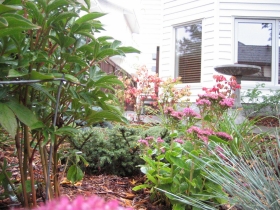Well this rain is really bringing us in the landscape industry down. It has been a rather wet couple of weeks here in Edmonton and we are falling behind. On a bright note as an owner operator we are able to catch up on some of that paperwork. So I think I will give out some pointers on how to mulch.
Mulch has several advantages over leaving soil bare. When weeds do come they are much easier to pull: sometimes they’re rooted only in the mulch itself and when they’re not, the soil underneath tends to be more friable. Beyond that, if you’re a mulch lover, a garden just doesn’t look finished without it. The first time you mulch, add your chosen product to two or three inches depth as soon as the soil warms up in spring. There is no need to take it away in the fall. Some of it, particularly with finer mulches, will break down through the growing season and over the winter, and you can top it up every year or two. My preference here in Edmonton is foothills premium mulch. Foothills tends to fade slower and it keeps the moisture in the ground better, which is good in Edmonton’s dry summers. Some mulches are more effective than others for different applications—such as stone being better for heat-loving plants and shredded bark better for woodland plants—but many popular plants are quite tolerant of all the variations (though grass clippings are really only suitable for lawns), so by all means: use what you like! It’s your garden. When it comes to mulching trees in particular, don’t overdo it. Never, never pile mulch up next to the trunk, and don’t lay it on six inches thick. Mulch around a newly planted tree will help keep it watered while it establishes a strong root system, but two inches is plenty, extending to the drip line or a little beyond. (Trees’ driplines aren’t an actual measurement of how far roots extend, but it’s an easy guideline for the home gardener.) A mature tree that is not

